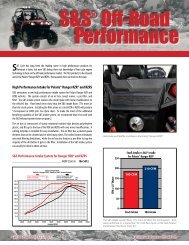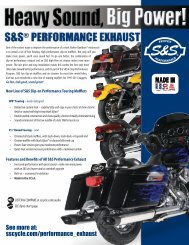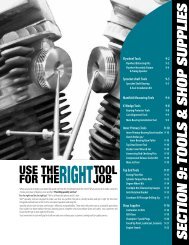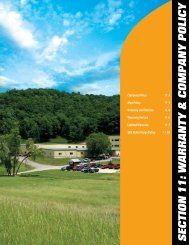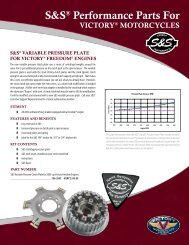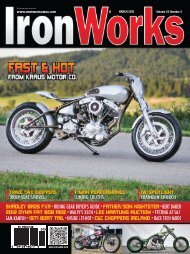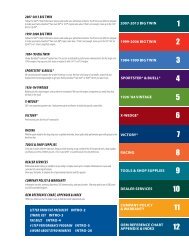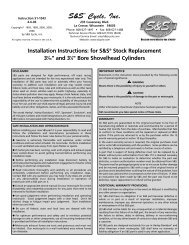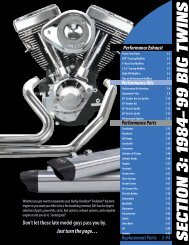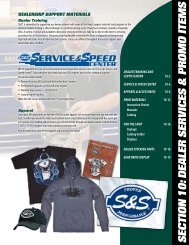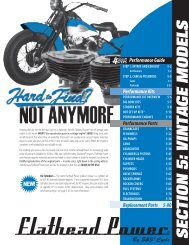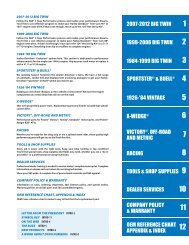Installation Instructions for General Flywheel - S&S Cycle
Installation Instructions for General Flywheel - S&S Cycle
Installation Instructions for General Flywheel - S&S Cycle
You also want an ePaper? Increase the reach of your titles
YUMPU automatically turns print PDFs into web optimized ePapers that Google loves.
6. Using lower oil return hole in cylinder spigots as aguide, drill 1 ⁄4" diameter connecting holes incrankcase to intercept holes drilled 5 ⁄8" deep in Step3. See Figure 2 and Picture 5. Driveside crankcaseDrill 1 ⁄4" diameter hole, 5 ⁄8" deepPicture 5NOTES● If base plates are to be used, be sure they are in place.● Lower oil return hole in current production S&S ® cylinders is1⁄2" on center below base gasket surface of cylinder. Thisdimension allows the use of up to 5" stroke using a 1 ⁄8" thickbase plate. Some early production cylinders have lower oilhole located about 5 ⁄16" on center below gasket surface.These early production cylinders can be used with strokes upto 4 3 ⁄4" where base plates are not used.●●●S&S big twin flywheels can be ordered machined to stock8 1 ⁄2" diameter or to small diameter (typically 8 1 ⁄4"). Smalldiameter flywheels are used mainly to provide extra pistonto flywheel clearance thus allowing the use of longer skirtedpistons in long stroke engines. There is also about a 2 pounddifference in weight between stock and small diameterflywheels. It is important to modify crankcases to acceptflywheels to be used. <strong>Flywheel</strong>s that are too small will leavea large gap between flywheels and oil scraper resulting inpoor oil scavenging and possible oil consumption problems.If flywheel diameter is smaller than diameter crankcaseswere machined to accept, scraper should be built up to rimof flywheels. Recommended clearance between flywheelsand scraper is .008" - .010".When sealing crankcase halves, S&S recommends use of hightemp resistant RTV premium silicone sealant or Hylomarsealant. Use any sealant sparingly to prevent particles ofexcess material from entering crankcase and potentiallygetting into engine oil.After flywheel assembly is installed in crankcases, rods must bechecked <strong>for</strong> straightness. S&S Rod Checking Pin, Part 53-0002,was designed to help per<strong>for</strong>m this procedure. It may also benecessary, to fabricate a rod bending tool as illustrated inFigure 3. The purpose of this procedure is to correct <strong>for</strong>machining tolerance discrepancies in components which maylead to pistons not running true in cylinder bores. While rodsmay be straight and true, it is sometimes necessary, to bendthem to correct <strong>for</strong> these machining discrepancies. Do notbend rod by using tool in wristpin hole as this method maydistort wristpin bushing. We also feel that using a piston inlieu of a checking pin may prove inaccurate due to variationsin lengths of piston skirts from one side of piston to the other.B. Clean dirt, filings, etc. out of passageways.C. Press a piece of 3 ⁄4" long x 3 ⁄8" O.D. steel tubing (Part93-1032) provided in kit into oil return hole in basegasket surface until tubing is flush with surface.Ream hole slightly with drill to remove any burrs thatmay exist.NOTE: A very tight press fit with 100% seal is not critical as tubewill sufficiently divert oil flow to new hole. Loctite ® may beapplied to tube if fit seems too loose.5. <strong>Installation</strong> Notes●●When pressing Timken ® bearings on sprocket shaft, be sureto lubricate the shaft. If this is not done the bearing may gallon the shaft and become stuck.Big twin engines using 1958 and later style pinon shaftsmay be assembled with any of the different styles ofpinon main bearing sets <strong>for</strong> 1958 and later engines. Ifnecessary, bearings can be spaced with thrust washers tocontrol end play and to insure that rollers run fully withinthe bearing race.Figure 3CAUTIONPistons which do not run true in cylinder bores may causeexcessive connecting rod side thrusting. This in turn may leadto premature ring, piston, connecting rod and rod bearingwear and eventual failure of these parts.6



